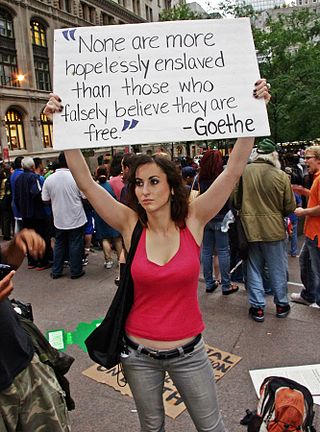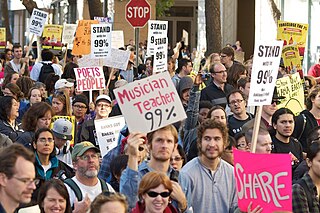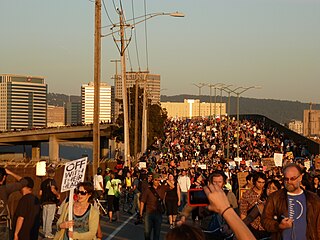
Lai Jean Quan is an American politician who was the 49th mayor of Oakland, California from 2011 to 2015. She previously served as City Council member for Oakland's 4th District. Upon inauguration on January 3, 2011, she became Oakland's first female mayor. Quan ran an unsuccessful campaign for reelection in 2014, losing the mayoral race to Libby Schaaf, a member of the Oakland City Council.

Occupy Wall Street (OWS) was a left-wing populist movement against economic inequality, corporate greed, big finance, and the influence of money in politics that began in Zuccotti Park, located in New York City's Financial District, and lasted for fifty-nine days—from September 17 to November 15, 2011.

The following is a timeline of Occupy Wall Street (OWS), a protest which began on September 17, 2011 on Wall Street, the financial district of New York City and included the occupation of Zuccotti Park, where protesters established a permanent encampment. The Occupy movement splintered after NYC Mayor Bloomberg had police raid the encampment in Zuccotti Park on November 15, 2011. The timeline here is limited to this particular protest during this approximate time-frame.

Occupy San José was a peaceful protest and demonstration in City Hall Plaza in San Jose, California. The demonstration was inspired by Occupy Wall Street and is part of the larger "Occupy" protest movement. The aim of the demonstration was to begin a sustained occupation in downtown San José, the 10th largest city in the United States, to protest perceived corporate greed and social inequality, including opposing corporate influence in U.S. politics, the influence of money and corporations on democracy and a lack of legal and political repercussions for the 2007–2008 financial crisis.

The Occupy movement was an international populist socio-political movement that expressed opposition to social and economic inequality and to the perceived lack of real democracy around the world. It aimed primarily to advance social and economic justice and different forms of democracy. The movement has had many different scopes, since local groups often had different focuses, but its prime concerns included how large corporations and the global financial system control the world in a way that disproportionately benefits a minority, undermines democracy and causes instability.

Occupy Oakland refers to a collaboration and series of demonstrations in Oakland, California, that started in October 2011. As part of the Occupy movement, protesters have staged occupations, most notably at Frank H. Ogawa Plaza in front of Oakland City Hall.

Occupy San Francisco was a collaboration that began with a demonstration event located at Justin Herman Plaza in the Embarcadero and in front of the Federal Reserve building on Market Street in the Financial District in San Francisco, California. It is based on the Occupy Wall Street movement that began in New York City on September 17, 2011 and is one of several "Occupy" protest sites in the San Francisco Bay Area; other sites include Occupy Oakland and Occupy San Jose.

The Occupy movement hand signals are a group of hand signals used by Occupy movement protesters to negotiate a consensus. Hand signals are used instead of conventional audible signals, like applause, shouts, or booing, because they do not interrupt the speaker using the human microphone, a system where the front of the crowd repeats the speaker so that the content can be heard at the back of the crowd. The signals have been compared to other hand languages used by soldiers, cliques and Wall Street traders.

Occupy Pittsburgh was a collaboration that has included peaceful protests and demonstrations, with an aim to overcome economic inequality, corporate greed and the influence of corporations and lobbyists on government. The protest has taken place at several locations in Pittsburgh, notably Market Square, Mellon Green and the city's Oakland neighborhood adjacent to the University of Pittsburgh and Carnegie Mellon University. and East Liberty neighborhood.

The Occupy movement spread to many other cities in the United States and worldwide beginning with the Occupy Wall Street protests in New York City in September 2011. The movement sought to advance social and economic justice and different forms of democracy but each local group varied in specific aims. The demonstrations and encampment in New York City spread to other major and smaller cities. Some camps lasted through 2012. What follows is an alphabetical, non-chronological summary of Occupy encampments in the United States.

The following is a timeline of Occupy Oakland which began on Monday, October 10, 2011, as an occupation of Frank H. Ogawa Plaza located in front of Oakland City Hall in downtown Oakland, and is an ongoing demonstration. It is allied with Occupy Wall Street, which began in New York City on September 17, 2011, and is one of several "Occupy" protest sites in the San Francisco Bay Area. Other sites include Occupy San Francisco and Occupy San Jose.

The UC Davis pepper spray incident occurred on November 18, 2011, during an Occupy movement demonstration at the University of California, Davis. After asking the protesters to leave several times, university police pepper sprayed a group of student demonstrators as they were seated on a paved path in the campus quad. The video of UC Davis police officer Lt. John Pike pepper-spraying demonstrators spread around the world as a viral video and the photograph became an Internet meme. Officer Alex Lee also pepper sprayed demonstrators at Pike's direction.
Occupy Texas State is a student activist group formed at Texas State University - San Marcos. It is distinguished from the off-campus but allied Occupy San Marcos.

Since September 2011, the Occupy movement has spread to over 80 countries and 2,700 towns and cities, including in over 90 cities in the United States alone. The movement has generated reactions from the media, the general public, the United States government, and from international governments.

Occupy Redwood City was a collaboration that began with peaceful protests, demonstrations, and general assemblies in front of the historic San Mateo County Courthouse in Redwood City, California. The demonstration was inspired by Occupy Wall Street and is part of the larger "Occupy" protest movement.
The Occupy movement has been met with a variety of responses from local police departments since its beginning in 2011. According to documents obtained by the Partnership for Civil Justice Fund, the FBI, state and local law enforcement officials treated the movement as a potential criminal and terrorist threat and used fusion centers and counterterrorism agents to investigate and monitor the Occupy movement.














